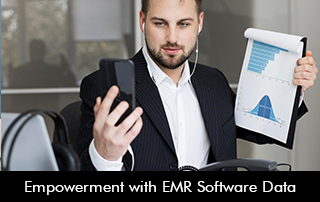There is a famous quote by Daniel Keys Moran, “You can have data without information, but you cannot have information without data.” This is very real. Data in Electronic Medical Software (EMR) Software improves patient outcomes and supports the provider’s decision-making process through critical information. Without the power of data in EHR Software, clinicians will be clueless about how to progress a patient treatment plan which can negatively impact public health as a whole. EMR Software has been widely implemented, with nearly 4 in 5 office-based physicians using the robust technology.
Types of Data in EMR Software
- Patient Demographics – Name, age, address, and contact details.
- Medical History – Family medicine history, past procedures, and treatments, allergies, and immunization records.
- Progress Notes – These are provider notes during a patient visit.
- Medications and Prescriptions – Medication history, pharmacy data, and active prescriptions.
- Vital Signs – These contain information about essential health metrics such as blood pressure, heart rate, oxygen saturation, etc.
- Lab Results – Imaging results, blood tests, and pathology findings.
- Clinical Orders – The data in EHR Software contains orders for lab results and referrals to specialists.
- Billing and Insurance Information
- Patient Scheduling Data including reminders and upcoming appointments.
Each of these data categories is critical in presenting a comprehensive and accurate picture of a patient’s health within the EMR system. This facilitates decision-making, treatment, and care continuity.
Empowerment with EHR Software Data
Provider Empowerment
Real-time access to full patient data in EMR Software such as medical history, lab results, and prescriptions enables healthcare practitioners to make informed, data-driven choices. This decreases diagnostic errors while improving treatment outcomes.
Electronic Medical Records Software data can be securely shared between healthcare teams and specialists, allowing for seamless collaboration and care coordination for patients requiring multidisciplinary treatment.
Patient Empowerment
Patient participation is facilitated by the patient portal platform in electronic health records software. Patients can have seamless access to their health information, schedule appointments, view lab results, and even communicate with their providers.
Patients can monitor their prescriptions with access to medication histories and real-time updates, lowering the risk of missed doses or hazardous drug interactions.
Empowerment with Telemedicine EMR Software Integration
Providers can deliver remote consultations using EHR systems that are integrated with telemedicine platforms, all while having access to the same comprehensive patient data. This makes it easier for patients to give and receive care, especially in underdeveloped areas, for both patients and doctors.
Telemedicine Software integration helps to improve access to care and facilitates remote care delivery. Non-urgent cases can be quickly and easily dealt with over virtual care consultations. This can boost health outcomes and even help with chronic disease management.







